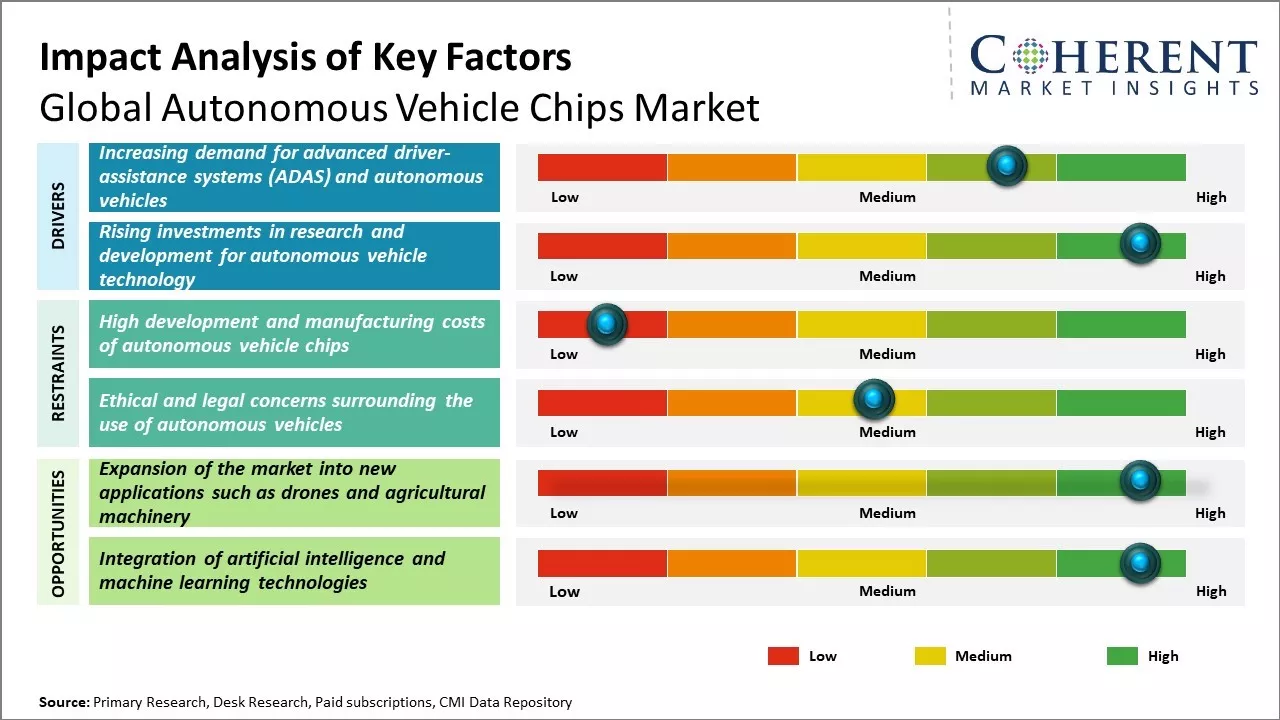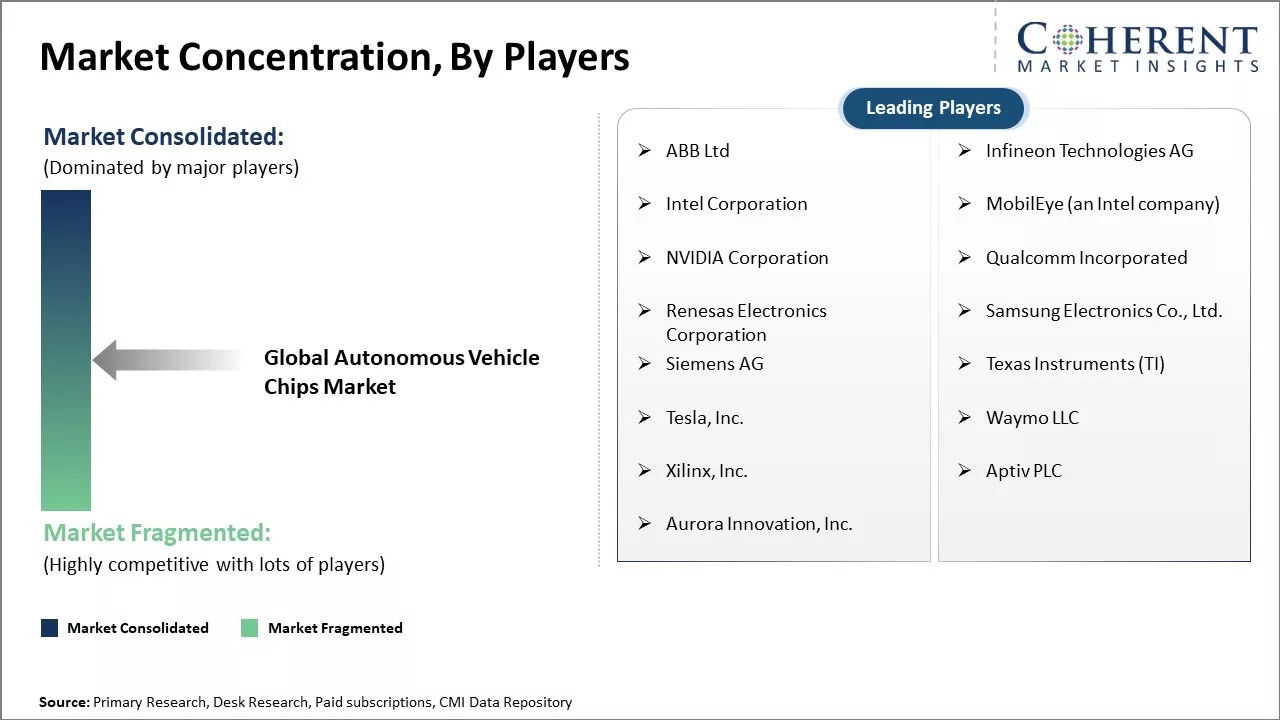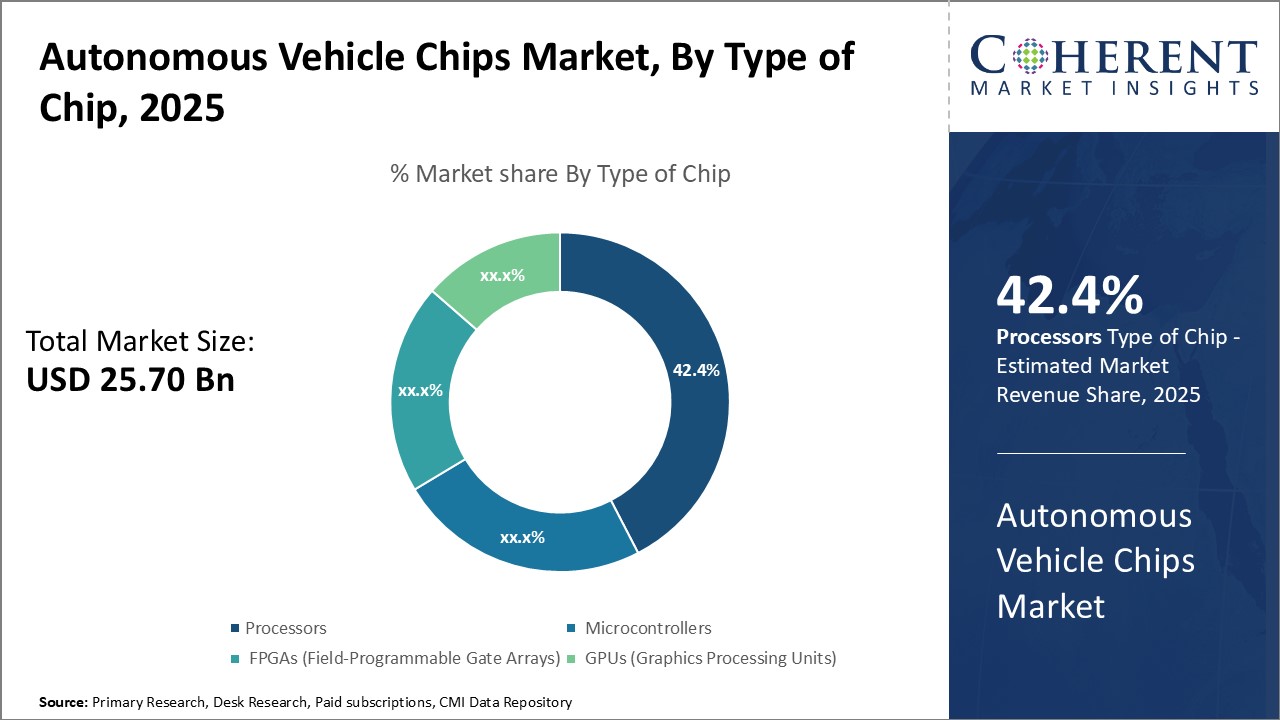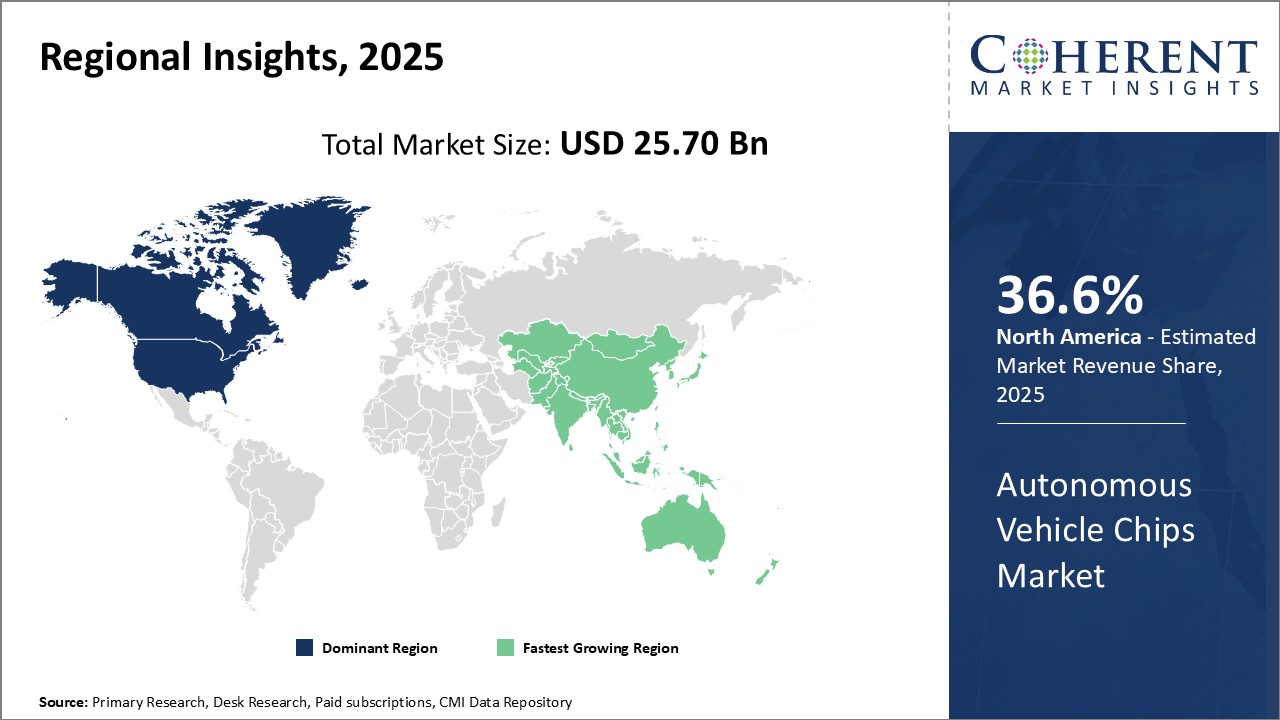Autonomous Vehicle Chips Market Size and Trends
Global autonomous vehicle chips market is estimated to be valued at USD 25.70 Bn in 2025 and is expected to reach USD 46.11 Bn by 2032, exhibiting a compound annual growth rate (CAGR) of 8.7% from 2025 to 2032.

Discover market dynamics shaping the industry: Download Free Sample
The rapid development of self-driving technologies and increasing demand for advanced driver-assistance systems are fueling the need for more sophisticated autonomous vehicle chips that can power functions like computer vision, sensor fusion, deep learning and artificial intelligence. The autonomous vehicle chips market trend shows significant growth as automakers continue to invest heavily in autonomous driving research and development. Rapid improvements in artificial intelligence and 5G connectivity are also supporting new chip designs with greater processing power, data transmission speed and lower power consumption. This is driving the development of safer, more affordable autonomous vehicles.
Market Driver - Increasing demand for advanced driver-assistance systems (ADAS) and autonomous vehicles
As advanced driver-assistance systems have evolved rapidly in recent years, penetrating deeper into consumer vehicles, the demand for autonomous vehicles capable of self-driving is on the rise. ADAS technologies have been improving safety on roads by offering features like adaptive cruise control, lane keeping assistance, blind spot monitoring, and automatic emergency braking. This has familiarized consumers with autonomous capabilities and piqued their interest in fully autonomous driving. Major automakers are vigorously working towards deploying self-driving vehicles and have accelerated their R&D spending to bring them to market in the next 5-10 years. The younger generation of drivers in particular is more open towards embracing new mobility options and sees considerable value in technologies freeing up travel time for other activities.
Consumer surveys have shown that a majority would feel more secure and comfortable travelling in an autonomous vehicle rather than a human-driven one given the safety risks from human errors. Several real-world pilot projects testing autonomous shuttles and taxis have proven the viability of driverless capabilities despite technical obstacles. Ride-hailing companies are actively pursuing autonomous fleet operations to optimize costs. Regulatory frameworks around the world are evolving to introduce regulatory clarity for deployment of autonomous vehicles. Technology giants as well as new players in the mobility space are pouring billions into autonomy to commercialize self-driving networks and services. While full autonomy may still be a few years away due to engineering challenges, the momentum clearly points towards growing consumer adoption once the technologies arrive at sufficient maturity and reliability.
Market Concentration and Competitive Landscape

Get actionable strategies to beat competition: Download Free Sample
Rising Investments in Research and Development for Autonomous Vehicle Technology
Automakers, technology companies, new mobility startups as well as governments worldwide have significantly ramped up investments to accelerate the development of autonomous driving systems. They recognize autonomous vehicles, once fully realized, will transform the entire mobility landscape by addressing critical issues of road safety, traffic efficiency, accessible transportation, and more. Therefore competing intensely to build leadership in this expanding sector viewed as a major long term opportunity. Major tech clusters in Silicon Valley, Detroit, Munich, and Tokyo have mobilized immense resources racing to solve the scientific and engineering challenges of autonomous driving such as sensor processing, navigation, and object recognition through deep learning algorithms.
Governments especially in Asia, Europe and North America offer sizable funding and subsidies for universities and companies pursuing autonomous vehicle research. Cities are collaborating to test autonomous fleets and build supporting infrastructure of 5G networks and HD mapping. Eventual commercialization of autonomous systems will usher in a new paradigm of mobility as a service replacing private vehicle ownership. This vision of the future transportation landscape where full autonomy is the norm acts as a powerful motivator for continued increase in dedication of capital towards speeding up development of self-driving vehicles and mastering all technical aspects to make that future possible. With so much at stake competitively and economically, investments in autonomous vehicle R&D look set to keep rising substantially in the coming years.
In March 2024, Mobileye Global Inc., an Israeli autonomous driving company acquired by Intel in 2017, launched its SuperVision Lidar chip designed for autonomous vehicles. This innovative chip integrates Mobileye's EyeQ system-on-chip with advanced computer vision algorithms and a custom Lidar sensor, enhancing the capabilities of self-driving technology.
Key Takeaways from Analyst:
The autonomous vehicle chips market has strong growth potential driven by the rising adoption of advanced driver assistance systems and autonomous driving technologies by automakers. Automotive semiconductor content per vehicle is expected to more than double by 2030 as autonomous functionalities become more commonplace. North America currently dominate the market owing to presence of major automakers aggressively working on self-driving technologies. However, Asia Pacific is anticipated to be the fastest growing regional market over the long term given the Chinese government's push for indigenous autonomous vehicle development and growing semiconductor manufacturing capabilities in the country.
Security continues to be a concern for automotive chipmakers as vehicles collect and store large amounts of consumer data. Companies need to ensure highest safety and privacy standards are followed. High research and development costs associated with autonomous technologies remain a key restraint to wider market adoption in the near term. Additionally, achieving the difficult goal of full self-driving capabilities could take longer than expected, slowing revenue growth projections for autonomous vehicle chips.
Continued decline in chip prices and greater functionality at lower costs will help expand the potential market. Partnerships between automakers and autonomous technology firms provide opportunities for specialized autonomous chips. The integration of AI and 5G connectivity also presents new avenues of growth over the coming decade.
Market Challenge - High development and manufacturing costs of autonomous vehicle chips
One of the major challenges faced by the global autonomous vehicle chips market is the high development and manufacturing costs associated with these chips. Autonomous vehicle chips require very powerful and efficient processing capabilities to handle the immense amount of data generated from on-board sensors such as cameras, radars, and lidars. Developing such advanced chips involve huge investments in R&D. Additionally, manufacturing next-generation autonomous vehicle chips with nanometer level technology is a complex process that demands substantial capital expenditure. The costs are further amplified due to low production volumes currently. While major automakers and chip manufacturers are investing heavily to commercialize self-driving technologies, the high costs pose serious challenges to scaling up the autonomous vehicles market particularly in price-sensitive developing nations. Cost reductions through technological advances and economies of scale would be crucial to accelerate the adoption of autonomous vehicles on a commercial basis.
Market Opportunity - Expansion of the market into new applications such as drones and agricultural machinery
The global autonomous vehicle chips market has a huge opportunity in the expansion into various new application areas beyond self-driving cars. With continual improvements in performance and reductions in costs, autonomous vehicle chips are finding increasing usage in diverse unmanned machines. For instance, drone technologies are growing rapidly for both commercial as well as defense applications. The deployment of autonomous drones for functions like surveillance, inspection, and delivery requires powerful onboard chips for navigating GPS coordinates, processing camera feeds, and making critical decisions in real-time. Similarly, autonomous machinery is revolutionizing agriculture through applications like crop monitoring, soil analysis, fertilizer spraying, and harvesting. All these unmanned machines leverage the machine learning and processing capabilities of autonomous vehicle chips. This emergence of new application verticals outside of traditional automotive is expected to drive exponential growth of the overall autonomous vehicle chips market in the coming years.

Discover high revenue pocket segments and roadmap to it: Download Free Sample
Insights By Type of Chip - Accelerating Autonomous Driving Increases Need for Advanced Processors
In terms of type of chip, processors segment is estimated to contribute 42.4% share of the market in 2025 owing to the rigorous processing power needs of autonomous vehicles. Advanced processors are essential for handling the vast amounts of data collected from a vehicle's sensors like cameras, radars and lidars. These sensors generate high resolution images and location data that needs to be analyzed in real-time for autonomous driving tasks like object detection, navigation and decision making. More specifically, powerful graphic processing units (GPUs) within processors play a critical role in deep learning capabilities that help autonomous vehicles recognize patterns from sensor inputs to understand the surrounding environment. As autonomous driving functionalities continue to progress towards higher levels of automation, the demand for next-generation processors with exponentially greater processing speeds and capacities will rise substantially. Automakers are aggressively investing in developing advanced computer systems focused on safety that leverage the latest processor technologies. The growing adoption of artificial intelligence and machine learning algorithms for self-driving capabilities also depends heavily on high-performance processors. These factors combined make processors indispensable for autonomous vehicles, driving its prominence as the largest segment in the Global Autonomous Vehicle Chips Market.
Insights By Application - Strengthening Mobility-as-a-Service Boosts Passenger Vehicles
In terms of application, passenger vehicles segment is estimated to contribute 51.8% share of the market in 2025 due to the expanding role of autonomous technology in mobility services. As shared mobility rises through transportation networks companies, autonomous shuttles and robo-taxis present lucrative opportunities for driverless passenger cars. More mainstream car ownership is giving way to on-demand access through mobility platforms. This transformation supports the scaling up of mobility-as-a-service operations centered on autonomous passenger vehicles. These driverless vehicles can provide affordable, convenient and accessible transportation around cities through services like shared shuttles and robo-taxis. There is potential to significantly reduce costs by removing human drivers from the system. Growing preference for alternative transportation modes like pooled rides also promotes automated passenger vehicles integrated with seamless digital booking systems. Partnerships between automakers, mobility providers and tech giants reflect industry efforts to commercialize self-driving passenger cars at an expedited rate. Rapid advancement of these initiatives will propel continued semiconductor demand from the passenger vehicles segment.
By End User - Safety and Efficiencies Catalyze Adoption across Logistics
In terms of end user, logistics and transportation segment is estimated to dominate the market revenue share with 65.9% in 2025 owing to the promising benefits of autonomous operation in cargo mobility. Driverless trucks and delivery vehicles can improve road safety by removing human errors from transportation fleets. Automated logistics also allow consistent operations over longer durations without breaks or fatigue compared to human-driven counterparts. This increases productivity and expedites deliveries through round-the-clock services. Autonomous capabilities further optimize routes and load planning through integration with advanced software systems. Significant cost savings can be achieved from reduced fuel consumption and labor expenses by replacing drivers with self-driving vehicles over time. Emerging platforms for long-haul freight and last-mile delivery increasingly explore autonomous technologies. Major logistics companies actively test driverless trucks to scale more efficient supply chain operations. Government support through regulatory sandboxes also encourages technology trials. Such initiatives are propelling semiconductor demand from the logistics and transportation industry as a key end user of autonomous vehicle solutions.
In June 2023, Renesas Electronics Corporation, a premier supplier of advanced semiconductor solutions for the automotive industry, announced the R-Car V4H system-on-chip (SoC) designed to power autonomous driving applications. The R-Car V4H SoC features deep learning performance of up to 34 TOPS (Tera Operations per Second), enabling high-speed image recognition and processing of surrounding objects using automotive cameras, radar, and lidar sensors. With its powerful combination of four Arm Cortex-A76 cores and dedicated computer vision accelerators, the R-Car V4H supports complex AI tasks and high-resolution imaging, significantly enhancing the perception and decision-making capabilities of autonomous vehicles. This cutting-edge SoC from Renesas is poised to play a crucial role in the development of advanced driver assistance systems (ADAS) and autonomous driving solutions, targeting the high-volume market segments of Level 2+ and Level 3 automation.
Regional Insights

Need a Different Region or Segment? Download Free Sample
North America has established itself as the dominant region in the global autonomous vehicle chips market with 36.6% share in 2025. The U.S. has taken an early lead in prototyping and testing of self-driving vehicles, with major tech companies and automakers aggressively investing in research and development. The availability of advanced connected vehicle infrastructure, partnerships between government and private entities, and concentration of chip design expertise have propelled North America ahead of other regions. Several major chip manufacturers are headquartered in the U.S. and have robust supply chains supporting automotive needs. The region also has a huge demand for advanced driver-assistance systems, creating a pull for latest semiconductors. Meanwhile, exports of autonomous vehicles and their components have enhanced the regions presence across international markets.
Asia Pacific has emerged as the fastest growing regional market, with China at the forefront. The rising focus of Chinese OEMs on electric and connected mobility, backed by strong support from the government, has accelerated chip requirements. Collaboration between domestic automakers and chipmakers has increased indigenous chip design capabilities. Several new chip factories have come up to cater to the expanding automotive sector. Japan and South Korea are also ramping up investments in next-gen automotive semiconductors, taking advantage of existing electronics expertise. Moreover, Asia Pacific has established itself as the largest EV market globally, generating substantial demand for autonomous driving semiconductors. The lower costs of chip manufacturing and availability of talent in countries like China and India are attracting investments from global firms looking to expand their AUT subsidiaries. The APAC regions focus on exports to developed automobile markets will further fuel its growth prospects.
Market Report Scope
Autonomous Vehicle Chips Market Report Coverage
| Report Coverage | Details | ||
|---|---|---|---|
| Base Year: | 2024 | Market Size in 2025: | USD 25.70 Bn |
| Historical Data for: | 2020 To 2024 | Forecast Period: | 2025 To 2032 |
| Forecast Period 2025 to 2032 CAGR: | 8.7% | 2032 Value Projection: | USD 46.11 Bn |
| Geographies covered: |
|
||
| Segments covered: |
|
||
| Companies covered: |
ABB Ltd, Infineon Technologies AG, Intel Corporation, MobilEye (an Intel company), NVIDIA Corporation, Qualcomm Incorporated, Renesas Electronics Corporation, Samsung Electronics Co., Ltd., Siemens AG, Texas Instruments (TI), Tesla, Inc., Waymo LLC, Xilinx, Inc., Aptiv PLC, and Aurora Innovation, Inc. |
||
| Growth Drivers: |
|
||
| Restraints & Challenges: |
|
||
Uncover macros and micros vetted on 75+ parameters: Get instant access to report
Autonomous Vehicle Chips Industry News
- In July 2024, Tesla, Inc., an American electric vehicle and clean energy company founded by Elon Musk, unveiled its latest Full Self-Driving Computer 3.0, a custom chip specifically designed for autonomous driving. This advanced chip delivers 21 TOPS of performance, marking a significant improvement over its predecessors, and is intended to enable Tesla's Autopilot system to achieve full self-driving capabilities in the future.
- In September 2023, NVIDIA Corporation, a leading global provider of graphics processing units (GPUs) and AI computing solutions, introduced its DRIVE Orin system-on-a-chip (SoC) designed specifically for autonomous driving applications. This powerful chip features advanced AI capabilities and enhanced processing power of up to 254 trillion operations per second (TOPS), enabling it to support complex algorithms and real-time decision-making in self-driving vehicles. DRIVE Orin is built on a scalable architecture that can support Level 2+ to Level 5 autonomous driving capabilities, making it a versatile solution for automakers and technology companies developing autonomous driving systems.
- In August 2023, Mobileye, an Israeli autonomous driving technology company and a subsidiary of Intel Corporation, announced the launch of its EyeQ Ultra chip, specifically designed for Level 4 and Level 5 autonomous vehicles. This advanced chip integrates multiple sensors and machine learning capabilities to enhance safety and navigation, providing superior performance for self-driving applications. The EyeQ Ultra is expected to play a crucial role in the development of autonomous driving solutions, further solidifying Mobileye's position as a leader in the autonomous vehicle technology market.
- In May 2023, Texas Instruments (TI), a global semiconductor company known for its innovative solutions in analog and embedded processing, introduced a new line of automotive safety microcontrollers tailored for advanced driver-assistance systems (ADAS) and autonomous vehicles. These microcontrollers are designed with a strong emphasis on reliability and safety, enhancing vehicle operations and contributing to the development of safer and more efficient automotive technologies.
*Definition: The Global Autonomous Vehicle Chips Market consists of semiconductor chips used in autonomous or self-driving vehicles to enable autonomous functionalities. The chips power critical autonomous driving systems like cameras, radars, sensors, control units and central processing units that process data from these systems to navigate roads and make driving decisions without human input. Major players in this market provide advanced chips with powerful processing capabilities required to handle the huge amounts of data gathered and analyzed for autonomous driving features to function.
Market Segmentation
- By Type of Chip Insights (Revenue, USD Bn, 2020 - 2032)
-
- Processors
- Microcontrollers
- FPGAs (Field-Programmable Gate Arrays)
- GPUs (Graphics Processing Units)
- By Application Insights (Revenue, USD Bn, 2020 - 2032)
-
- Passenger Vehicles
- Commercial Vehicles
- Defense Vehicles
- Public Transport Vehicles
- By End User Insights (Revenue, USD Bn, 2020 - 2032)
-
- Automotive
- Logistics and Transportation
- Defense
- Others
- By Regional Insights (Revenue, USD Bn, 2020 - 2032)
- North America
- U.S.
- Canada
- Latin America
- Brazil
- Argentina
- Mexico
- Rest of Latin America
- Europe
- Germany
- U.K.
- Spain
- France
- Italy
- Russia
- Rest of Europe
- Asia Pacific
- China
- India
- Japan
- Australia
- South Korea
- ASEAN
- Rest of Asia Pacific
- Middle East
- GCC Countries
- Israel
- Rest of Middle East
- Africa
- South Africa
- North Africa
- Central Africa
- North America
- Key Players Insights
-
- ABB Ltd
- Infineon Technologies AG
- Intel Corporation
- MobilEye (an Intel company)
- NVIDIA Corporation
- Qualcomm Incorporated
- Renesas Electronics Corporation
- Samsung Electronics Co., Ltd.
- Siemens AG
- Texas Instruments (TI)
- Tesla, Inc.
- Waymo LLC
- Xilinx, Inc.
- Aptiv PLC
- Aurora Innovation, Inc.
Share
Share
About Author
Monica Shevgan has 9+ years of experience in market research and business consulting driving client-centric product delivery of the Information and Communication Technology (ICT) team, enhancing client experiences, and shaping business strategy for optimal outcomes. Passionate about client success.
Missing comfort of reading report in your local language? Find your preferred language :
Transform your Strategy with Exclusive Trending Reports :
Frequently Asked Questions
EXISTING CLIENTELE
Joining thousands of companies around the world committed to making the Excellent Business Solutions.
View All Our Clients
